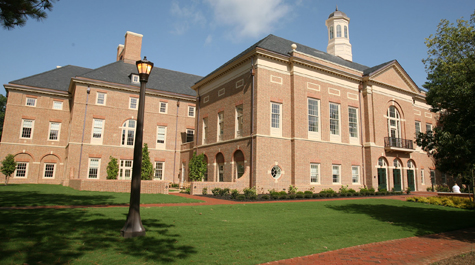Miller Hall receives LEED gold
The home of the business school of one of the country's "public ivies," Alan B. Miller Hall, has received a Leadership in Energy and Environmental Design (LEED®) Gold Certification from the U.S. Green Building Council.
Seen as the western gateway to campus, Miller Hall features a multitude of collaborative learning spaces, including: 11 classrooms, two 24-seat seminar rooms, a 4000 sq. ft. multi-purpose room with seating for 400, an electronic trading room/classroom for financial markets courses, an enhanced business library and a communications laboratory.
"We are obviously delighted by this news," noted Dean Lawrence B. Pulley. "Taking a leadership role in the College's efforts in sustainable building design was a project goal from the outset. We are now focused on applying the same principles in how we operate and utilize the facility."
While the aesthetics of the building reference the past, the new Mason School of Business features the latest in high performance design principles and practices. The building has been registered under the U.S. Green Building Council's LEED® Green Building Rating System version 2.2. It is the first building on the William & Mary campus to receive LEED Gold certification.
The certification was based on six categories: water efficiency, indoor environmental quality, sustainable site design and development, innovative design process, energy design and use of materials and resources.
In building Miller Hall, the Mason School of Business:
· Reduces potable water usage by 32.9 percent as compared to a typical similar sized building.
· Uses 23.5 percent less energy as compared to a similar sized building.
· Captures rainwater runoff in an underground cistern and uses that for irrigation.
· Restored nearly 71 percent of the site with planted native or adaptive species. Previously, the site of Miller Hall was a parking lot.
LEED® is an internationally recognized green building certification system, providing third-party verification that a building or community was designed and built using strategies aimed at lessening the impact on the environment.
Dedicated in October 2009, and named for W&M alumnus Alan B. Miller '58, Miller Hall is a symbol of the enduring spirit of William & Mary. "I have seen how an extraordinary building can elevate an entire institution," noted Miller in his dedication remarks. Miller founded Universal Health Services, Inc., the third largest proprietary hospital management company in the United States, in 1978. "This building will elevate everyone involved. It will elevate faculty, staff, students and everyone who sees it."
Deemed a 100-year building, the new home of Mason maintains a connection to the landscape that has been part of the campus's legacy since the Sunken Garden, the hedge-lined lawn around which the historic campus is organized, was conceived by Thomas Jefferson. Miller Hall was designed by the world-renowned architectural firm Robert A.M. Stern Architects, LLP.
"The Mason School of Business presented us with a wonderful and daunting challenge: to meet the high expectations of a forward-looking institution while respecting the great architectural heritage of the William & Mary campus," said Graham S. Wyatt, AIA, the partner in charge of the project at Robert A.M. Stern Architects. "We are convinced that sustainable design is compatible with all types of architectural expression -- in short, that sustainability is not a style — and with Miller Hall we have demonstrated that today's values can be integrated successfully into the traditions of a great university."
For more information about Alan B. Miller Hall, visit its website. Skip to main content
Skip to main content

